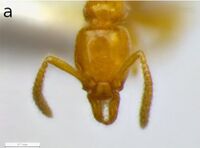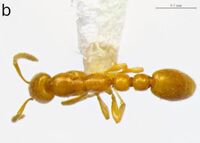Protanilla flamma
| Protanilla flamma | |
|---|---|

| |
| Scientific classification | |
| Kingdom: | Animalia |
| Phylum: | Arthropoda |
| Class: | Insecta |
| Order: | Hymenoptera |
| Family: | Formicidae |
| Subfamily: | Leptanillinae |
| Tribe: | Leptanillini |
| Genus: | Protanilla |
| Species: | P. flamma |
| Binomial name | |
| Protanilla flamma Baidya & Bagchi, 2020 | |
The two known specimens of this species were collected during field work in Netravali Wildlife Sanctuary at the foothills of the Western Ghats of Goa. The specimens were collected during the post-monsoon season of 2016, when the top 4 cm thick leaf-litter and 2-3 cm of soil was disturbed to reveal the collected individuals within the soil. The area where the specimens were collected is situated at an elevation of 445 m above sea level with thick forest canopy, mostly dominated by moist-deciduous tree species. The forest floor was still wet from the just concluded monsoons and the temperature at the site on the time of collection was 33C.
Identification
Baidya and Bagchi (2020) - In terms of the number of mandibular teeth and the structure of petiolar and post-petiolar nodes, Protanilla flamma appears morphologically close to Protanilla lini. However, the new species can be very easily differentiated based on the short antennal scape which does not exceed the posterior margin of the head (SI 91.0in comparison to P. lini where the scape exceeds the posterior margin of the head (SI 104.2).
In terms of individual morphometric measurements (TL, HL, HW, SL, PW, WL, PNL, PNH, PNW, PPNL, PPNH and PPNW) the new species has generally smaller features than the other congeneric species. In two-dimensional ordination space, the new species is closer to Protanilla wardi, described from Kerala, India than the other Protanilla species.
Keys including this Species
Distribution
Distribution based on Regional Taxon Lists
Oriental Region: India (type locality).
Distribution based on AntMaps
Distribution based on AntWeb specimens
Check data from AntWeb
Countries Occupied
| Number of countries occupied by this species based on AntWiki Regional Taxon Lists. In general, fewer countries occupied indicates a narrower range, while more countries indicates a more widespread species. |

|
Biology
Castes
Nomenclature
The following information is derived from Barry Bolton's Online Catalogue of the Ants of the World.
- flamma. Protanilla flamma Baidya & Bagchi, 2020: 20, figs. 1a-c (w.) INDIA.
Description
Worker
Holotype: TL2.5, HL 0.428, HW 0.355, CI 82.944, SL 0.323, SI 90.986, ML 0.249, PW 0.227, WL0.724, PNL 0.199, PNH 0.288, PNW 0.218, PI 109.548, PPNL 0.179, PPNH 0.279, PPNW 0.221, PPI 123.464.Paratype: TL2.45, HL 0.425, HW 0.350, CI 82.353, SL 0.300, SI 85.714, ML 0.230, PW 0.225, WL 0.70, PNL 0.190, PNH 0.285, PNW 0.213, PI 112.105, PPNL 0.174, PPNH 0.275, PPNW 0.217, PPI 124.713. Body uniformly bright yellow and shiny. In full face, head longer than broad, anteriorly narrow with evenly convex sides. Antero-lateral corners of head produced into prominent angles. Posterior margin of head gently concave. Eyes absent. Mandibles elongated, smooth and shiny, apically strongly down-curved, basal margin rounded and masticatory margin with ~10 peg like teeth and a longitudinal groove runs along the dorsolateral margin of the mandible. Clypeus in full face is trapezoidal with depressed longitudinal central line, anterior margin Body uniformly bright yellow and shiny. In full face, head longer than broad, anteriorly narrow with evenly convex sides. Antero-lateral corners of head produced into prominent angles. Posterior margin of head gently concave. Eyes absent. Mandibles elongated, smooth and shiny, apically strongly down-curved, basal margin rounded and masticatory margin with ~10 peg like teeth and a longitudinal groove runs along the dorsolateral margin of the mandible. Clypeus in full face is trapezoidal with depressed longitudinal central line, anterior margin slightly concave. Antenna 12 segmented; scape short not exceeding the posterior margin of the head; segments 2-4 wider than long; segments 5-10 nearly as long as broad; terminal segment almost twice as long than broad. In profile view, dorsum of pronotum gently convex, and approximately twice the size of mesonotum. Promesonotal suture distinct and slightly depressed. Dorsum of mesonotum almost straight and sloping downwards. Metanotal groove strongly notched. Dorsum of propodeum slopes posteriorly, postereodorsal corner rounded. Petiolar node narrows slightly upwards; anterior and posterior faces both straight and dorsum slightly convex. Subpetiolar process reduced. Post-petiolar node straight with dorsum slightly convex; ventral face strongly inclined forward and anteroventral corner blunt; broadly attached to abdominal segment with free posterior face above the articulation with segment IV. Gaster oval in shape and more constricted anteriorly; length of Tergite I more than half the length of gaster. Sting well developed.
In dorsal view, mesonotum constricted, and 1.5 times smaller in width than the pronotum. Petiolar and post-petiolar nodes as long as broad with convex sides and of comparable size. Anterior margin of abdominal segment IV deeply concave to accept the laterally compressed post-petiole. Dorsum of head, mesosoma, petiolar node, post-petiolar node and gaster, with short pubescence. Entire body covered sparsely with suberect hairs.
Type Material
- Holotype, worker, Goa, South Goa District, Netravali Wildlife Sanctuary, 445m asl, India, 15°35′56″N 74°14′24″E / 15.599°N 74.240°E, 25.ix.2016, Pronoy Baidya, Indian Institute of Science, Bengaluru; hand collected in moist deciduous forest.
- Paratype, 1 worker, Goa, South Goa District, Netravali Wildlife Sanctuary, 445m asl, India, 15°35′56″N 74°14′24″E / 15.599°N 74.240°E, 25.ix.2016, Pronoy Baidya, Gandhi Krishi Vignana Kendra, Bengaluru; hand collected in moist deciduous forest.
Etymology
The name of the new species is inspired by Prof. Vaibhav Chindarkar. In Sanskrit, “vaibhav” means eminence –like the glow of a flame in the dark. Incidentally, this species is also yellowish-orange in colour. Hence, “flamma”.
References
- Aswaj, P., Anoop, K., Priyadarsanan, D.R. 2020. First record of the rarely collected ant Protanilla gengma Xu, 2012 (Hymenoptera, Formicidae, Leptanillinae) from the Indian subcontinent. Check List 16, 1621–1625 (doi:10.15560/16.6.1621).
- Baidya, P., Bagchi, S. 2020. A new species of Protanilla Taylor 1990 (Hymenoptera: Formicidae: Leptanillinae) from India. Halteres 11: 19-24 (doi:[https://doi.org/10.5281%2Fzenodo.39%0A%2A%5B%5BMedia%3ABaidya%2C+P.%2C+Bagchi%2C+S.+2021.+Influence+of+human+land+use+and+invasive+species+on+beta+diversity+of+tropical+ant+assemblages+%2810.1111%40icad.12536%29.pdf%7CBaidya%2C+P.%2C+Bagchi%2C+S.+2021.+Influence+of+human+land+use+and+invasive+species+on+beta+diversity+of+tropical+ant+assemblages.+Insect+Conservation+and+Diversity%2C+icad.12536%5D%5D+%28doi%3A%5Bhttps%3A%2F%2Fdoi.org%2F10.1111%252Ficad.12536+10.1111%2Ficad.12536%5D%29.%0A41686 10.5281/zenodo.39
- Baidya, P., Bagchi, S. 2021. Influence of human land use and invasive species on beta diversity of tropical ant assemblages. Insect Conservation and Diversity, icad.12536 (doi:10.1111/icad.12536).
41686]).
- Griebenow, Z. 2024. Systematic revision of the ant subfamily Leptanillinae (Hymenoptera, Formicidae). ZooKeys 1189, 83–184 (doi:10.3897/zookeys.1189.107506).
- Griebenow, Z.H., Isaia, M., Moradmand, M. 2022. A remarkable troglomorphic ant, Yavnella laventa sp. nov. (Hymenoptera: Formicidae: Leptanillinae), identified as the first known worker of Yavnella Kugler by phylogenomic inference. Invertebrate Systematics 36(12), 1118-1138 (doi:10.1071/is22035).
- Yamada, A., Van Dang, A., Eguchi, K. 2023. Natural history notes of the rare enigmatic ant Opamyrma hungvuong: A first glimpse of their preying behavior on centipedes (Hymenoptera: Formicidae: Leptanillinae). Asian Myrmecology 16, e016009 (doi:10.20362/am.016009).

